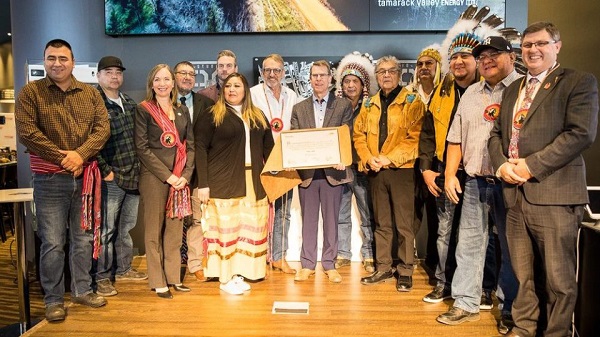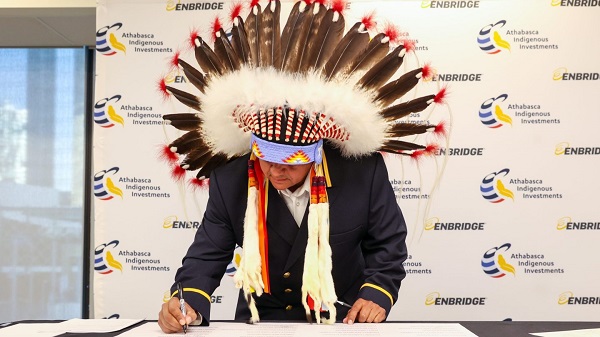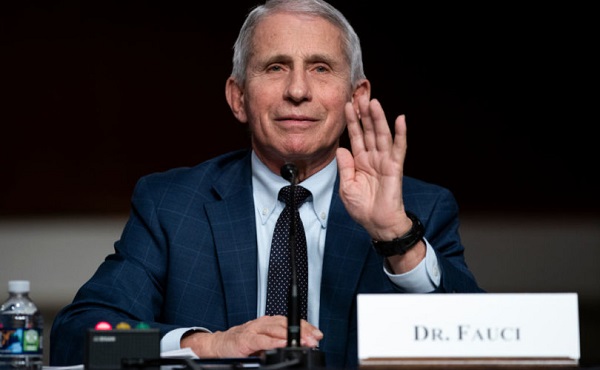Canadian Energy Centre
Alberta Indigenous energy ownership driving increased economic activity

In December 2023, the Alberta Indigenous Opportunities Corporation provided a $150 million loan guarantee to support the 12 Indigenous Communities of Wapiscanis Waseskwan Nipiy Limited Partnership (including the Peerless Trout First Nation) in financing an equity investment in oil and gas midstream infrastructure in the Clearwater play in Northern Alberta. Photo courtesy AIOC
From the Canadian Energy Centre
By Will Gibson
‘We live in a new world, and I’m excited about the possibilities’
Five pristine lakes sit in and around the Peerless Trout First Nation in the unbroken boreal forest of north-central Alberta about 200 kilometres north of Slave Lake.
When asked about the fishing, Tyler Letendre smiles wryly. “It lives up to the name,” says the Nation’s director of operations and economic development officer. “It’s peerless.”
The community’s leadership is exploring the idea of building a lodge to lure recreational anglers from across North America to reel in the large pike, trout and walleye that inhabit the dark blue waters in those lakes.
After joining the Clearwater Infrastructure Limited Partnership in December 2023 with 11 other Indigenous communities and Tamarack Valley Energy, they have the financial clout to develop a resort.
“Joining the partnership has been a game changer for our nation, 100 per cent. We won’t compromise on treaty rights, but we are big fans of economic growth,” says Letendre.
“The money provided by the federal government to First Nations isn’t enough to sustain the programs and infrastructure required so we have to generate our own income. Equity deals like Clearwater do that,” he says.
“We are shareholders along with major institutions. We now have banks who want to come invest in our communities. We live in a new world, and I’m excited about the possibilities.”

The Peerless Trout First Nation is located about 200 kilometres north of Slave Lake, Alberta. Photo courtesy Peerless Lake First Nation
The growing number and value of Indigenous equity ownership deals in Alberta is helping fuel stronger participation in the province’s economy, according to a recently released report from ATB Financial and MNP.
The study concluded that total Indigenous economic activity in Alberta grew by a substantial 42 per cent between 2019 and 2023.
Last year, Indigenous-owned businesses generated $5.25 billion in economic output, $380 million in tax revenues and $1.33 billion in labour income from 25,800 full-time jobs.
The resource sector has an outsized impact in this area as its relationship with First Nations and Métis communities in Alberta has evolved and grown.
“The fastest growing and largest opportunities for Indigenous communities in Alberta come from the resource sector,” says Justin Bourque, president of Âsokan Generational Developments, a consultancy that specializes in partnerships between Indigenous communities and industry.
He says the evolution of the relationship between Indigenous communities and the resource sector has mirrored the broader progress of reconciliation.
“Our entire society is on a journey of reconciliation between Indigenous and non-Indigenous communities. The engagement and relationship between the resource industry and Indigenous has continued to evolve.”
In recent years, particularly following the creation of the Alberta Indigenous Opportunities Corporation (AIOC) in 2019, these relationships have increasingly moved from short-term benefits to long-term legacies through equity ownership deals like Peerless Trout’s agreement with Tamarack Energy.

Justin Bourque, president of Âsokan Generational Developments, pictured on his trap line with the Long Lake oil sands facility in the background. Photo for Canadian Energy Centre
ATB highlighted the Astisiy project in the oil sands region, a Cree word meaning “thread from sinew” that is used for Indigenous beading.
In September 2021, Suncor Energy and the AIOC enabled eight Indigenous communities to acquire 15 per cent ownership of the Northern Courier Pipeline, a 90-kilometre system that transports bitumen from the Fort Hills mine to the East Tank Farm north of Fort McMurray.
The community partners are projected to receive $16 million in annual payments from the deal.
Bourque’s Willow Lake Métis Nation has used its portion of the revenues to purchase a 205-acre parcel southeast of Fort McMurray, giving the community land to call its own.
“Ownership and partnership is the next logical evolution of the relationship between Indigenous communities and the energy sector,” says Bourque.
“Before Indigenous communities had the opportunity to invest in these resource assets, a lot of the economic value out of these investments would flow to institutional investors along with the corporation,” he says.
“By having some of those benefits flow into Indigenous communities, it builds both resilience by giving them financial sovereignty and allows that community to address priorities and needs determined by them, not somebody in Ottawa.”
Opportunities are now happening at the Peerless Trout First Nation.
“Our chief and council are in the best position to decide what works for the 900 members of Peerless Lake when it comes to how to invest the monies from the partnership, whether that’s in housing, education, health care, more post-secondary scholarships or building a hockey arena or community facility,” Letendre says.
Canadian Energy Centre
First Nations in Manitoba pushing for LNG exports from Hudson’s Bay

From the Canadian Energy Centre
By Will Gibson
NeeStaNan project would use port location selected by Canadian government more than 100 years ago
Building a port on Hudson’s Bay to ship natural resources harvested across Western Canada to the world has been a long-held dream of Canadian politicians, starting with Sir Wilfred Laurier.
Since 1931, a small deepwater port has operated at Churchill, Manitoba, primarily shipping grain but more recently expanding handling of critical minerals and fertilizers.
A group of 11 First Nations in Manitoba plans to build an additional industrial terminal nearby at Port Nelson to ship liquefied natural gas (LNG) to Europe and potash to Brazil.
Robyn Lore, a director with project backer NeeStaNan, which is Cree for “all of us,” said it makes more sense to ship Canadian LNG to Europe from an Arctic port than it does to send Canadian natural gas all the way to the U.S. Gulf Coast to be exported as LNG to the same place – which is happening today.
“There is absolutely a business case for sending our LNG directly to European markets rather than sending our natural gas down to the Gulf Coast and having them liquefy it and ship it over,” Lore said. “It’s in Canada’s interest to do this.”
Over 100 years ago, the Port Nelson location at the south end of Hudson’s Bay on the Nelson River was the first to be considered for a Canadian Arctic port.
In 1912, a Port Nelson project was selected to proceed rather than a port at Churchill, about 280 kilometres north.
The Port Nelson site was earmarked by federal government engineers as the most cost-effective location for a terminal to ship Canadian resources overseas.
Construction started but was marred by building challenges due to violent winter storms that beached supply ships and badly damaged the dredge used to deepen the waters around the port.
By 1918, the project was abandoned.
In the 1920s, Prime Minister William Lyon MacKenzie King chose Churchill as the new location for a port on Hudson’s Bay, where it was built and continues to operate today between late July and early November when it is not iced in.
Lore sees using modern technology at Port Nelson including dredging or extending a floating wharf to overcome the challenges that stopped the project from proceeding more than a century ago.
He said natural gas could travel to the terminal through a 1,000-kilometre spur line off TC Energy’s Canadian Mainline by using Manitoba Hydro’s existing right of way.
A second option proposes shipping natural gas through Pembina Pipeline’s Alliance system to Regina, where it could be liquefied and shipped by rail to Port Nelson.
The original rail bed to Port Nelson still exists, and about 150 kilometers of track would have to be laid to reach the proposed site, Lore said.
“Our vision is for a rail line that can handle 150-car trains with loads of 120 tonnes per car running at 80 kilometers per hour. That’s doable on the line from Amery to Port Nelson. It makes the economics work for shippers,” said Lore.
Port Nelson could be used around the year because saltwater ice is easier to break through using modern icebreakers than freshwater ice that impacts Churchill between November and May.
Lore, however, is quick to quell the notion NeeStaNan is competing against the existing port.
“We want our project to proceed on its merits and collaborate with other ports for greater efficiency,” he said.
“It makes sense for Manitoba, and it makes sense for Canada, even more than it did for Laurier more than 100 years ago.”
Canadian Energy Centre
Why nation-building Canadian resource projects need Indigenous ownership to succeed

Chief Greg Desjarlais of Frog Lake First Nation signs an agreement in September 2022 whereby 23 First Nations and Métis communities in Alberta will acquire an 11.57 per cent ownership interest in seven Enbridge-operated oil sands pipelines for approximately $1 billion. Photo courtesy Enbridge
From the Canadian Energy Centre
U.S. trade dispute converging with rising tide of Indigenous equity
A consensus is forming in Canada that Indigenous ownership will be key to large-scale, nation-building projects like oil and gas pipelines to diversify exports beyond the United States.
“Indigenous ownership benefits projects by making them more likely to happen and succeed,” said John Desjarlais, executive director of the Indigenous Resource Network.
“This is looked at as not just a means of reconciliation, a means of inclusion or a means of managing risk. I think we’re starting to realize this is really good business,” he said.
“It’s a completely different time than it was 10 years ago, even five years ago. Communities are much more informed, they’re much more engaged, they’re more able and ready to consider things like ownership and investment. That’s a very new thing at this scale.”
 John Desjarlais, executive director of the Indigenous Resource Network in Bragg Creek, Alta. Photo by Dave Chidley for the Canadian Energy Centre
John Desjarlais, executive director of the Indigenous Resource Network in Bragg Creek, Alta. Photo by Dave Chidley for the Canadian Energy Centre
Canada’s ongoing trade dispute with the United States is converging with a rising tide of Indigenous ownership in resource projects.
“Canada is in a great position to lead, but we need policymakers to remove barriers in developing energy infrastructure. This means creating clear and predictable regulations and processes,” said Colin Gruending, Enbridge’s president of liquids pipelines.
“Indigenous involvement and investment in energy projects should be a major part of this strategy. We see great potential for deeper collaboration and support for government programs – like a more robust federal loan guarantee program – that help Indigenous communities participate in energy development.”
In a statement to the Canadian Energy Centre, the Alberta Indigenous Opportunities Corporation (AIOC) – which has backstopped more than 40 communities in energy project ownership agreements with a total value of over $725 million – highlighted the importance of seizing the moment:
“The time is now. Canada has a chance to rethink how we build and invest in infrastructure,” said AIOC CEO Chana Martineau.
“Indigenous partnerships are key to making true nation-building projects happen by ensuring critical infrastructure is built in a way that is competitive, inclusive and beneficial for all Canadians. Indigenous Nations are essential partners in the country’s economic future.”
Key to this will be provincial and federal programs such as loan guarantees to reduce the risk for Indigenous groups and industry participants.
“There are a number of instruments that would facilitate ownership that we’ve seen grow and develop…such as the loan guarantee programs, which provide affordable access to capital for communities to invest,” Desjarlais said.
 Workers lay pipe during construction of the Trans Mountain pipeline expansion on farmland in Abbotsford, B.C. on Wednesday, May 3, 2023. CP Images photo
Workers lay pipe during construction of the Trans Mountain pipeline expansion on farmland in Abbotsford, B.C. on Wednesday, May 3, 2023. CP Images photo
Outside Alberta, there are now Indigenous loan guarantee programs federally and in Saskatchewan. A program in British Columbia is in development.
The Indigenous Resource Network highlights a partnership between Enbridge and the Willow Lake Métis Nation that led to a land purchase of a nearby campground the band plans to turn into a tourist destination.
“Tourism provides an opportunity for Willow Lake to tell its story and the story of the Métis. That is as important to our elders as the economic considerations,” Willow Lake chief financial officer Michael Robert told the Canadian Energy Centre.
The AIOC reiterates the importance of Indigenous project ownership in a call to action for all parties:
“It is essential that Indigenous communities have access to large-scale capital to support this critical development. With the right financial tools, we can build a more resilient, self-sufficient and prosperous economy together. This cannot wait any longer.”
In an open letter to the leaders of all four federal political parties, the CEOs of 14 of Canada’s largest oil and gas producers and pipeline operators highlighted the need for the federal government to step up its participation in a changing public mood surrounding the construction of resource projects:
“The federal government needs to provide Indigenous loan guarantees at scale so industry may create infrastructure ownership opportunities to increase prosperity for communities and to ensure that Indigenous communities benefit from development,” they wrote.
For Desjarlais, it is critical that communities ultimately make their own decisions about resource project ownership.
“We absolutely have to respect that communities want to self-determine and choose how they want to invest, choose how they manage a lot of the risk and how they mitigate it. And, of course, how they pursue the rewards that come from major project investment,” he said.
-

 2025 Federal Election10 hours ago
2025 Federal Election10 hours agoBREAKING: THE FEDERAL BRIEF THAT SHOULD SINK CARNEY
-

 2025 Federal Election11 hours ago
2025 Federal Election11 hours agoCHINESE ELECTION THREAT WARNING: Conservative Candidate Joe Tay Paused Public Campaign
-

 2025 Federal Election21 hours ago
2025 Federal Election21 hours agoOttawa Confirms China interfering with 2025 federal election: Beijing Seeks to Block Joe Tay’s Election
-

 2025 Federal Election21 hours ago
2025 Federal Election21 hours agoReal Homes vs. Modular Shoeboxes: The Housing Battle Between Poilievre and Carney
-

 2025 Federal Election2 days ago
2025 Federal Election2 days agoCarney’s budget means more debt than Trudeau’s
-

 International2 days ago
International2 days agoPope Francis has died aged 88
-

 Business2 days ago
Business2 days agoCanada Urgently Needs A Watchdog For Government Waste
-

 2025 Federal Election21 hours ago
2025 Federal Election21 hours agoHow Canada’s Mainstream Media Lost the Public Trust



